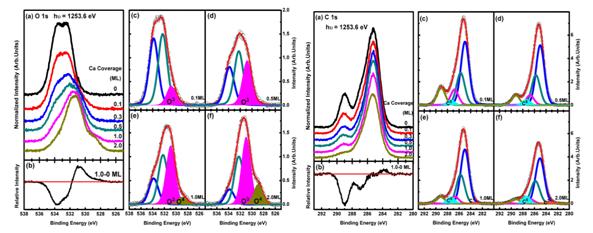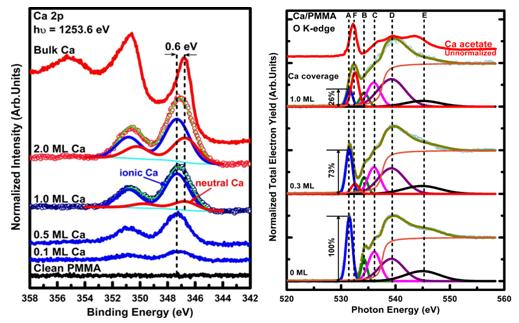| Ca Carboxylate Formation at the Calcium/Poly(methyl methacrylate) Interface |
| From: PublishDate:2013-06-15 Hits: |
The interfaces between metals and polymers are of considerable importance in wide-ranging applications, especially in optoelectronic devices, packing, and coatings, because metal layers are usually deposited on polymer films as key functional components (e.g., electrodes and coatings). Therefore, a thorough understanding of the nature at the interfaces between metals and polymers can provide important guidance for practical manufacturing. The Surface Physics & Chemistry Group of University of Science and Technology of China (USTC) has studied the chemical interaction between Ca and Poly(methyl methacrylate) (PMMA) at room temperature. Their research has been published on September 4th, 2012 in The Journal of Physical Chemistry C. The group combines X-ray photoemission spectroscopy (XPS) and near-edge X-ray absorption fine structure spectroscopy (NEXAFS) to comprehensively study the interfacial interaction during deposition of Ca onto the PMMA surface at room temperature. The changes of the O 1s, C 1s, and Ca 2p core level XP spectra upon Ca deposition directly indicate that Ca atoms preferentially react with the ester groups of PMMA at very low coverages, leading to the formation of polymeric Ca carboxylate and loss of methyl groups. The O K-edge NEXAFS spectra carried out at the beamline 4B9B in the Beijing Synchrotron Radiation Facility (BSRF) further confirm that the ester groups of the PMMA are the primary active sites for reaction with Ca atoms.
Left:XP spectra of the O 1s and peak fitting results for Ca deposition on PMMA with different coverages;Right: XP spectra of the C 1s and peak fitting results for Ca deposition on PMMA with different coverages.
Left: XP spectra of the Ca 2p and peak fitting results for Ca deposition on PMMA with different coverages; Right: Normalized oxygen K-edge NEXAFS spectra recorded in the TEY mode on the PMMA surface with different Cacoverages. The complementary results from XPS and NEXAFS stronglyconfirm the reaction mechanism between Ca and PMMA, and will greatlycontributetoward further understanding of the interfaces between metalsand polymers. These also show that the chemically sensitive analyticaltechniques play an important role in studies of metal/polymer interfaces, especially NEXAFScan provide complementaryinformation to that obtained by XPS for the interfacialinteraction.
Article: HuanxinJu,XuefeiFeng, Yifan Ye, Liang Zhang, Haibin Pan, Charles T. Campbell, and Junfa Zhu*,Ca Carboxylate Formation at the Calcium/Poly(methyl methacrylate) Interface.J. Phys. Chem. C, 116, 20465−20471, 2012. |
|
|
| Chinese
Science Highlights
Home /
Copyright © 2011 - 2012 Beijing Synchrotron Radiation Facility



